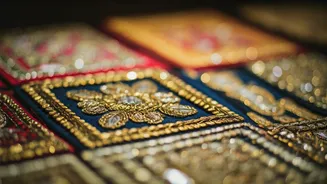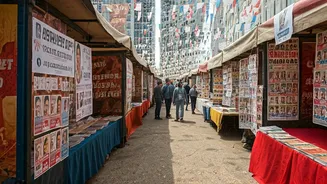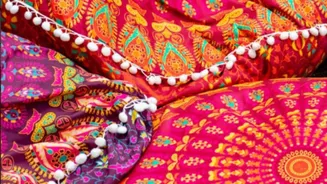A Stitch of History
Embroidery, a time-honored craft, holds a significant place in India's cultural heritage. These intricate designs, painstakingly crafted by skilled artisans,
narrate tales of tradition and artistry. The legacy of embroidery is not simply about clothing and embellishments, it embodies a deep connection to history, regional identity, and the skill of generations of craftspeople. Each stitch and thread is a testament to the country's rich past, offering insight into the lives, customs, and artistic expressions of different communities across the nation. Styles like Zardozi and Phulkari have become synonymous with luxury and cultural expression.
Zardozi: Royal Radiance
Originating from Persia, Zardozi arrived in India during the Mughal era and quickly became associated with royal courts. The style's name, meaning 'gold embroidery' in Persian, captures its luxurious essence. Zardozi uses metallic threads – typically gold and silver – to create elaborate, raised designs on fabrics like silk, velvet, and satin. This technique, requiring immense skill and precision, often features motifs of flowers, vines, and royal symbols. Today, Zardozi continues to be used in bridal wear and other festive garments, symbolizing wealth, status, and the enduring allure of traditional craftsmanship. The craft showcases the exquisite combination of history and artistic expertise.
Phulkari: Blooming Threads
Phulkari, meaning 'flower work,' is a vibrant embroidery style from Punjab, representing joy, fertility, and celebration. Primarily crafted by women, Phulkari designs are characterized by their bold, geometric patterns and use of vibrant colored floss silk threads on a cotton base. The designs often depict flowers, leaves, and other motifs inspired by nature and daily life. Each piece of Phulkari is a testament to familial ties and community bonding. Typically worn during weddings and other auspicious occasions, Phulkari's bright colors and lively patterns reflect the spirit of Punjabi culture and the artistry passed down through generations. The technique has gained prominence for its festive and symbolic value.
Gota Patti: Golden Glamour
Gota Patti is a Rajasthani embroidery technique, showcasing intricate gold or silver ribbon embellishments on fabrics. This process involves attaching small, metallic ribbons, cut into various shapes, onto the fabric to create patterns and designs. Gota Patti work is especially popular for creating borders, floral motifs, and geometric patterns on garments. This decorative embroidery is often used on festive and bridal wear, giving a rich, elegant look. The technique is a prime example of the state's traditional craftsmanship and is a mainstay in the region’s cultural and festive garments, enhancing their beauty and appeal.
Aari: Fine Chain Stitch
Aari embroidery is a fine chain stitch technique originating from the Indian subcontinent, known for its delicate and intricate designs. The embroidery uses a hooked needle, called an 'aari,' to create fine, detailed patterns on various fabrics. The Aari method creates designs that include floral motifs, paisleys, and geometric forms. This art form is especially prominent in Kashmir and Lucknow and is used on a wide range of materials, including silk, cotton, and velvet, making it a valuable method for embellishing clothing. Its refined style makes it a cherished craft, valued for its beauty and the artisanal skills. This meticulous and elegant embroidery technique brings out the finest details.
Chamba Rumal: Painted Stories
The Chamba Rumal is a unique form of embroidery from Himachal Pradesh, merging embroidery and painting techniques. These handkerchiefs, traditionally made by women, feature intricate, double-sided embroidery that depicts scenes from the epics, religious tales, and daily life. The embroidery is done with fine silk threads, creating colorful, detailed narratives on the fabric. The distinctive style is characterized by its artistic expression, storytelling, and cultural significance. Each Rumal is a work of art, telling a visual story with every stitch and color. These are cherished for their artistic depth and cultural relevance, symbolizing the rich heritage of the region.
Parsi Gara: Colorful Tales
Parsi Gara embroidery blends Chinese and Persian design influences, reflecting the history of the Parsi community in India. The style combines delicate, detailed embroidery with vibrant colors and often features floral and bird motifs. This intricate technique adorns sarees and other garments. Parsi Gara is distinguished by its blend of cultural influences, its distinctive aesthetics, and rich visual appeal. The embroidery style captures the Parsi community's history, blending Chinese and Persian elements. It is cherished for its beauty, rich cultural context, and the delicate skill involved in its creation, making it a treasured craft.
Toda: Tribal Geometry
Toda embroidery, practiced by the Toda tribe of the Nilgiri Hills in Tamil Nadu, is a unique and geometric style. The embroidery is distinguished by its bold patterns and use of red and black threads on a white base cloth, often creating striking geometric designs. This embroidery is done on shawls and garments, reflecting the tribal community's connection to nature and their traditions. The embroidery has a distinctive tribal identity, and is recognized for its geometric designs. This style represents the culture of the Toda people, showcasing their distinctive artistic skills. The Toda embroidery serves as a visual language, communicating the tribe’s rich cultural heritage.
Sujani: Storytelling Quilts
Sujani embroidery from Bihar is a form of quilting and embroidery, creating lightweight quilts used for warmth and gifting. The embroidery incorporates simple running stitches to form intricate patterns, depicting daily life, nature, and cultural motifs. Sujani work is commonly crafted using recycled or repurposed fabrics, promoting sustainability and resourcefulness. It represents the community's resourcefulness. This form of artistry not only provides comfort but also conveys stories through its artistic depictions. The quilts reflect the life and cultural traditions of Bihar. The art showcases the communities' capacity to reuse materials and make them beautiful.
Tilla: Kashmiri Sparkle
Tilla embroidery from Kashmir uses metallic threads, mainly gold or silver, to create sparkling designs on fabrics. It involves stitching these threads to create intricate patterns that shimmer and shine. Tilla is often seen on traditional Kashmiri garments, adding a luxurious and festive look. The technique highlights the skills of artisans. The art adds a rich, glittering element, and is associated with weddings, celebrations, and festive events. Tilla embroidery enhances the beauty of textiles and reflects the rich cultural legacy of the region.













